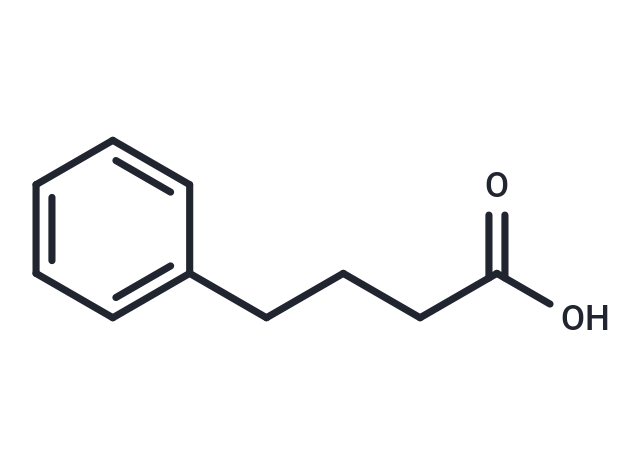Shopping Cart
Remove All Your shopping cart is currently empty
Your shopping cart is currently empty
4-Phenylbutyric acid (Benzenebutyric acid) is a histone deacetylase (HDAC) inhibitor and an endoplasmic reticulum stress (ERS) inhibitor. 4-Phenylbutyric acid can be used to treat urea cycle disorders.

| Pack Size | Price | USA Warehouse | Global Warehouse | Quantity |
|---|---|---|---|---|
| 200 mg | $30 | In Stock | In Stock | |
| 500 mg | $39 | In Stock | In Stock | |
| 1 g | $53 | In Stock | In Stock | |
| 5 g | $106 | - | In Stock | |
| 10 g | $156 | - | In Stock | |
| 1 mL x 10 mM (in DMSO) | $29 | In Stock | In Stock |
| Description | 4-Phenylbutyric acid (Benzenebutyric acid) is a histone deacetylase (HDAC) inhibitor and an endoplasmic reticulum stress (ERS) inhibitor. 4-Phenylbutyric acid can be used to treat urea cycle disorders. |
| In vitro | METHODS: ERp57 KO and control cells were treated with 4-Phenylbutyric acid (50 mM) and protein expression levels were detected by Immunoblot analysis. RESULTS: Levels of ER stress marker proteins BiP, Chop and IRE1 were increased in ERp57 KO cells compared to control cells, indicating higher levels of ER stress in the absence of ERp57. 50 mM 4-Phenylbutyric acid treatment was effective in ERp57 KO cells and reduced protein levels of all three ER stress markers. protein levels of all three ER stress markers. In the case of IRE1, ER stress proteins were even reduced below the levels of control cells. [1] METHODS: A549 cells and primary nasal epithelial cells were treated with 4-Phenylbutyric acid (0-20 mM) for 72 h. Cell viability was measured by MTT assay. RESULTS: Cells were examined after treatment with 4-Phenylbutyric acid concentrations ranging from 0-20 mM, and cell survival was not affected below 10 mM. [2] |
| In vivo | METHODS: To study the effects on obese mice, 4-Phenylbutyric acid (120 mg/kg) was administered intraperitoneally to KK-Ay mice fed Lieber-DeCarli diet (5% EtOH) once daily for ten days. On day 11, a single dose of EtOH (4 g/kg) was administered by gavage. RESULTS: In an obese mouse model, chronic overdose of EtOH induced massive ER stress-related oxidative stress and liver injury through dysregulation of unfolded protein responses. 4-Phenylbutyric acid ameliorated the liver injury induced by chronic addition of overdose of EtOH by decreasing ER and oxidative stress after overdose of EtOH. [3] |
| Synonyms | Benzenebutyric acid |
| Molecular Weight | 164.2 |
| Formula | C10H12O2 |
| Cas No. | 1821-12-1 |
| Smiles | C(CCC(O)=O)C1=CC=CC=C1 |
| Relative Density. | 1.0326 g/cm3 (Estimated) |
| Color | White |
| Appearance | Solid |
| Storage | Powder: -20°C for 3 years | In solvent: -80°C for 1 year | Shipping with blue ice/Shipping at ambient temperature. | ||||||||||||||||||||||||||||||||||||||||
| Solubility Information | DMSO: 262.5 mg/mL (1598.66 mM), Sonication is recommended. H2O: 1.65 mg/mL (10.05 mM), Sonication and heating are recommended. | ||||||||||||||||||||||||||||||||||||||||
| In Vivo Formulation | 10% DMSO+40% PEG300+5% Tween 80+45% Saline: 12.5 mg/mL (76.13 mM), Solution. Please add the solvents sequentially, clarifying the solution as much as possible before adding the next one. Dissolve by heating and/or sonication if necessary. Working solution is recommended to be prepared and used immediately. The formulation provided above is for reference purposes only. In vivo formulations may vary and should be modified based on specific experimental conditions. | ||||||||||||||||||||||||||||||||||||||||
Solution Preparation Table | |||||||||||||||||||||||||||||||||||||||||
H2O/DMSO
DMSO
| |||||||||||||||||||||||||||||||||||||||||
| Size | Quantity | Unit Price | Amount | Operation |
|---|

Copyright © 2015-2026 TargetMol Chemicals Inc. All Rights Reserved.